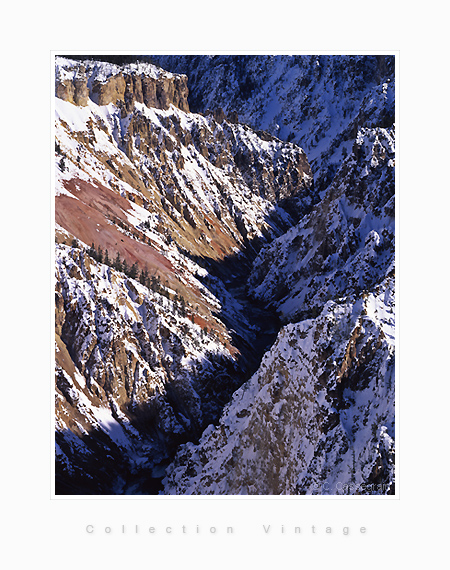

"Take only photographs, leave only footprints." Hamish
Fulton

Rare are the moments when light seems to settle and gently caress the material world. Chance or opportunity - an encounter between the photographer and his subjet. Equipment The use of the photographic medium (view camera) is certainly the noblest of ways to bear witness to the different elements and details of a landscape. It gives the photographer the possibility of becoming a part of the scenery during the different phases of camera adjustment. A photographer takes photographs according to the rhythms of light, not the rhythm of time. The format of the rendered image (from 4x5 inch to 8x10 inch) reveals all the details of the image clearly and precisely. The photographic medium enables several different adjustments (movements), the main ones being: decentration and the Scheimpflug principle (law of conjugate planes). In the context of this specific case, decentration and forward tilt of the camera were used in order to frame the subject as desired.
Face to face with the bisonFebruary 1996 - Flagstaff (Arizona) 2.30 a.m. I get up and decide I'm going to check the Rand McNally road map for the distance between Flagstaff (Arizona) and Jackson Hole (Wyoming). About 1300 kms and four states to cross! If I leave now, I can be there by tonight. It will be a unique opportunity to see the park under a mantle of snow. 3 a.m. 5.15 a.m. 8.30 a.m. 11.30 a.m. 2 p.m. 6 p.m. 7.15 p.m. The next morning, I discover an extraordinary landscape. The town is surrounded by the cordillera of "Teton Range" and "Gros Ventre Range" - sumptuous and impressive. I head off in the direction of Yellowstone National Park, following route 191. To my left, the mountain chain of "Teton Range", covered with an immaculate mantle of snow, crowned by the majestic Mt Wister. Down below winds Snake River, which flows from Jackson Lake. The nature here is wild, savage, and a magnificent feast for the eyes. At the entrance to Yellowstone Park, I can no longer continue in my car. To gain access to the park itself, I need to hire a snow-bike. The guide quickly explains how the thing works, and once I've attached the photo equipment to the back, I roar off in the direction of Yellowstone. In 1996, you could still explore the park on your own in winter-time. But since the end of the 1990's, you're no longer allowed to take the trip alone, you have to travel with a guide. After more than 2 hours travelling on the snow-bike, my first stop is at Old Faithful Geyser. The geyser spouts every hour and a half, to a height of between 30 and 50 metres, for a period of between one and five minutes. All around, a multitude of smaller geysers create a surrealistic setting. Old Faithful Lodge is almost deserted. Now I have to make a choice - which direction to take to continue my visit of the Park. Yellowstone Park is larger than Corsica, and there's only one, 8-shaped road through it. No way could I travel the whole route in a day. The snow-covered road and the intense cold (-20°) don't help. I decide to head for Yellowstone Canyon, situated 90 kms to the east of Old Faithful. Along the way, everything around me looks somehow supernatural. Snow is falling heavily, covering the plains, and bison forage for their food, heads buried in the snow. As I'm driving along to Yellowstone Canyon, I'm suddenly halted by a group of a dozen bison who seem to have taken over the road. I stop the snow-bike at a reasonable distance, and wait, watching them carefully. Twenty minutes go by, but they don't seem to want to move. But I have to keep going. My heart thumps wildly as I accelerate gently, moving to within a dozen metres from the group. After a few seconds, they move to leave a passage a few metres wide through the middle of the group. My hand trembling on the throttle, I take this chance to move on - as I'm seated on the snow-bike, the bison tower above me. I'm so close to them that I can feel the heat from their huge bodies. A few more metres and I'm past! As I drive away from them, the passage closes behind me. It's only afterwards that I realise how lucky I've been! And then - Yellowstone Canyon. It's slopes are covered with snow, and the iron which is present in the rocks expresses splashes of yellow and red. 300 metres further below, the river, a ribbon of silver, flows peacefully by. Such splendour! I savour the moment while I take a few photos. Back at my car at the exit of Yellowstone Park, after a day filled with emotion - and a few aching muscles - I have only one desire - to get back to Salt Lake City to develop the film and see the result. February 1996 |
© 1998-2026 - C. Cassegrain Photograph - All rights reserved v.01 - Mobile : +33 6 71 26 04 76 |